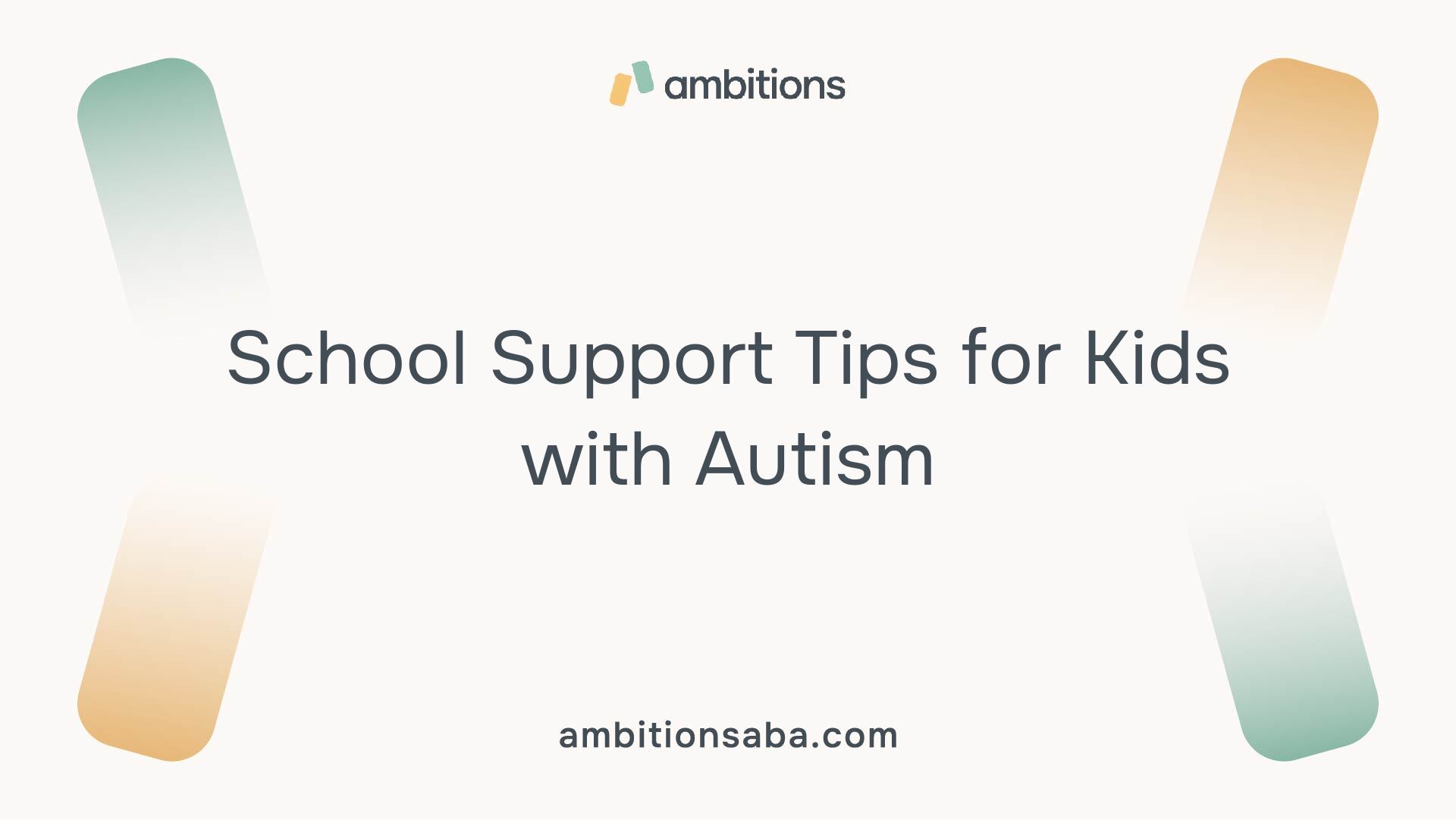Discover financial assistance for autism! From government programs to scholarships, find the support you need for your child's journey.
Supporting Autistic Children in School

Inclusive Education Benefits
Inclusive education offers significant advantages for both autistic and non-autistic students. This approach fosters social skills, understanding, and acceptance among peers, thereby creating a supportive learning environment. Research shows that when children learn together, they develop empathy and improve their communication skills, which benefits everyone involved. This supportive atmosphere can help autistic children feel more accepted and less isolated, leading to better emotional and academic outcomes. For more insights on this topic, visit building social skills in autism.
Benefits of Inclusive EducationEnhances social skills among all studentsPromotes understanding and acceptanceCreates a sense of belonging for autistic studentsImproves overall academic performance
Tailoring Instruction for Autistic Students
Tailoring instruction is essential for engaging all students effectively, especially those with autism. Adapting teaching methods to accommodate various learning styles ensures comprehension of the material. For example, some students may benefit from visual aids, while others may respond better to hands-on activities. Creating individualized approaches helps meet the specific needs of autistic children, allowing them to thrive in the classroom.
Collaborative efforts between families and school teams play a key role in this process. It is important for teachers and parents to communicate regularly about the strengths and challenges of the child. This teamwork not only supports academic learning but also encourages autonomy and engages autistic students in their educational experience.
Instructional Strategies for Autistic StudentsUse of visual schedules and aidsHands-on learning opportunitiesIncorporation of sensory breaksFlexible grouping for activities
Empowering autistic students by providing them with a voice is vital in the educational setting. Involving them in their Individualized Education Program (IEP) meetings and allowing them to set personal goals fosters a sense of control and ownership over their learning experience. For more about empowering children with autism, refer to our article on parenting tips for children with autism.
By promoting these inclusive and tailored educational practices, schools can create an environment where all students, especially those with autism, can succeed and develop essential life skills.
Positive Reinforcement Strategies

Implementing positive reinforcement strategies can play a significant role in motivating and guiding autistic students toward improved behavior and academic success. These techniques help create a supportive learning environment, fostering engagement and accomplishments.
Motivating Autistic Students
Motivating students with autism often involves utilizing tailored approaches that resonate with their unique interests and strengths. Positive reinforcement strategies, such as token economies and praise, can be effective in this context. Here are some examples of motivational techniques:
StrategyDescriptionToken EconomiesStudents earn tokens for completing tasks or demonstrating positive behaviors. These tokens can be exchanged for rewards such as extra playtime or special privileges.Praise and EncouragementVerbal affirmation or small rewards can significantly increase a student's motivation to engage in the classroom. Acknowledging their efforts helps build self-esteem.Preferred ActivitiesIncorporating activities that students enjoy can increase motivation to participate in less preferred tasks. For example, a child may work harder on a math assignment if they know they will get to play a favorite game afterward.
To ensure effective motivation, it is crucial for educators and parents to understand the individual child's interests and preferences. This knowledge allows for the creation of a tailored motivational system that encourages participation and reinforces positive actions. For further guidance on promoting social skills, see our article on building social skills in autism.
Effective Behavior Reinforcement
Effective behavior reinforcement can enhance the learning experience for autistic children, paving the way for better academic and social outcomes. By reinforcing desired behaviors with positive attention and rewards, educators can help students develop essential skills and improve their classroom behavior.
Key elements of effective behavior reinforcement include:
Through effective behavior reinforcement, educators can support autistic students in successfully navigating social interactions and academic challenges. For resources on managing common challenges faced by children with autism, check out overcoming common autism challenges.
Creating Sensory-Friendly Environments
Creating supportive and accommodating environments for autistic children can greatly enhance their learning experience. By implementing sensory-friendly tools and strategies, schools can help manage sensory overload and foster an inclusive atmosphere.
Tools for Sensory Support
Equipping classrooms with sensory-friendly tools can significantly aid students in managing sensory challenges. These tools help students focus better and feel more comfortable in their environments. Some effective sensory support tools include:
ToolDescriptionNoise-Canceling HeadphonesReduce auditory distractions, helping students concentrate on their tasks.Weighted BlanketsProvide calming pressure, offering students comfort and security during stressful situations.Visual AidsInclude picture schedules and social stories to assist in understanding routines and expectations.AAC DevicesAugmentative and Alternative Communication devices can support communication for non-verbal students.
Utilizing these tools can create a quieter, more structured environment, making it easier for children with autism to thrive in school. For additional insights on enhancing communication, visit our article on building social skills in autism.
Strategies for Managing Overload
In addition to specific tools, implementing effective strategies is crucial for preventing sensory overload. Here are some practical approaches to managing sensory sensitivity in autism:
By carefully selecting tools and employing thoughtful strategies, parents and educators can significantly contribute to creating sensory-friendly environments. These practices not only enhance academic performance but also improve overall well-being and social participation for children diagnosed with autism.
Collaborative Approach in Autism Education
Importance of Collaboration
Collaboration is a crucial aspect of supporting autistic children in educational settings. It ensures a consistent approach for interventions, allowing both home and school environments to work seamlessly together. Working collectively with families, teachers, and special education professionals can significantly enhance the educational experience of autistic students.
A strong partnership between families and school teams promotes the success of autistic children. Such collaboration involves engaging with teachers, educational assistants, school-based teams, and community partners to achieve positive outcomes. Ultimately, autistic students thrive when they have the autonomy to make their own decisions, fostering a sense of ownership in their educational journey.
Parents play an essential role in this collaborative model. Their involvement can heavily influence their children’s educational achievements. Including parents in the decision-making process ensures that the specific needs of their child are met, and their insights are valuable for devising effective strategies. The Effective Routines for Autistic Kids article shows how structured routines can build a collaborative framework that aids learning.
Involving Special Education Professionals
Involving special education professionals is key to fostering a collaborative approach in autism education. Special education practitioners bring specialized knowledge and skills to the table, making them vital partners in developing individualized educational programs (IEPs) tailored for autistic students.
Collaboration with special education professionals allows for:
AdvantageDescriptionConsistent InterventionsA unified approach in implementing interventions across home and school environments.Customized StrategiesTailoring strategies based on the unique needs and strengths of the child.Shared ResourcesAccess to tools and resources that support effective learning and behavior management.Advocacy SupportAssistance in defending students' rights to receive the necessary services and accommodations [3].
Effective collaboration with special education professionals can also lead to successful implementation of various therapies. Parents can explore therapies complementing ABA for autism to enhance their child’s learning strategies. When everyone involved is on the same page, children with autism are more likely to experience meaningful educational outcomes and personal growth.
In conclusion, nurturing a collaborative approach between families, teachers, and special education professionals creates a supportive learning environment. This synergy equips autistic children with the tools they need to thrive academically and socially. For further insights, parents can check recommendations about building social skills in autism.
Advocacy and Communication with Schools
Advocacy and communication are critical when it comes to supporting children with autism in educational settings. Parents play an essential role in ensuring that their children's rights are defended and that open lines of communication with schools are maintained.
Defending Student Rights
Understanding and defending the rights of autistic students is paramount. Each child has the right to an inclusive education tailored to their unique needs. Parents should be knowledgeable about relevant laws and regulations, such as the Individuals with Disabilities Education Act (IDEA), which mandates that all children receive a Free Appropriate Public Education (FAPE).
RightDescriptionRight to FAPEAll students are entitled to a free appropriate public education.Right to InclusionStudents should have opportunities for inclusion in general education classrooms.Right to SupportAccess to necessary support services and accommodations is guaranteed.
Advocacy requires collaboration with schools to ensure that these rights are upheld. Building trusting relationships with school personnel helps facilitate productive dialogue regarding the needs of autistic students.
Effective Parent-School Communication
Effective communication between parents and schools can significantly enhance the educational experience for autistic children. Parents should maintain open lines of communication with teachers and support staff to discuss their child's progress and any concerns that may arise. Regular updates through meetings, emails, or phone calls encourage ongoing collaboration.
Some tips for effective communication include:
Collaboration is crucial for crafting an effective education plan, as it combines the insights of teachers, special education professionals, and families. By advocating for their children and maintaining strong communication with schools, parents can help create a supportive environment conducive to their child’s success in the classroom.
Building Inclusive Classroom Environments
Creating a supportive and inclusive classroom environment for autistic children involves strategic approaches that foster understanding and engagement. Two key areas to focus on include effective strategies for inclusion and the implementation of structured routines.
Strategies for Inclusion
Inclusion strategies in classrooms aim to create a nurturing learning atmosphere for all students, including those with autism. Visual aids play a vital role in this process. Tools like the Picture Exchange System can enhance communication and learning for autistic students, especially those who may be nonverbal, as many of them are visual learners [5].
StrategyDescriptionVisual AidsUtilizing tools like charts, symbols, and images to communicate and teach concepts effectively.Sensory-Friendly AdjustmentsImplementing changes such as using earplugs, dimming lights, and arranging seating for comfort to minimize sensory overload.Interest-Based ActivitiesAligning classroom activities with the child's interests to encourage natural social interactions.Organized Social OpportunitiesStructuring activities such as playdates and social skills groups to help children engage comfortably and confidently with peers.
These strategies help create an inclusive environment where children with autism can thrive educationally and socially.
Structured Routines for Autistic Students
Establishing structured routines is beneficial for autistic students, as predictability supports their learning process. Routines help to reduce anxiety associated with uncertainty, allowing children to focus on learning. A well-organized daily schedule provides a visual element that clarifies what to expect throughout the day.
Key Elements of Structured RoutinesDescriptionClear SchedulesProviding a visual timetable that outlines daily activities and transitions.Consistent ExpectationsSetting clear behavioral and academic expectations to help students understand what is required of them.Flexibility in StructureIncorporating some flexibility to accommodate individual needs while maintaining overall structure. (effective routines for autistic kids)Regular ReviewsPeriodic discussions about the schedule can help students understand and adapt to changes.
By implementing structured routines, educators can create a sense of stability and security, which is essential for autistic children to succeed academically and socially. For more insights on enhancing social skills, check out our article on building social skills in autism.
References
[2]:
[3]:
[4]:
[5]:

